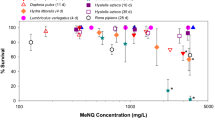Abstract
2-Amino-4,6-dinitrotoluene (2A-DNT) is a metabolite of the explosive 2,4,6-trinitrotoluene (TNT) which is present in the soil at numerous U.S. Army installations as the result of TNT manufacture or training activities. Although many avian species are known to inhabit areas where 2A-DNT has been found in the environment, no published studies of the effects of 2A-DNT exposure in birds are available. In this study, we conducted an evaluation of the oral toxicity of 2A-DNT in a representative ground foraging species of management concern, the northern bobwhite (Colinus virginianus). Subacute (14 days) and subchronic (60 days) oral gavage exposure studies were conducted following determination of the median acute lethal dose (LD50 = 1167 mg/kg). In the subacute study, survival occurred at 50 mg/kg/day. This helped to determine dose groups for the subchronic study: 0, 0.5, 3, 14, and 30 mg 2A-DNT/kg body weight-d in corn oil. The lowest observed adverse effects level (LOAEL) was determined to be 14 mg/kg/day based on mortality, and the no observed adverse effects level (NOAEL) was determined to be 3 mg/kg/day based on lack of effects at this exposure level.

Similar content being viewed by others
References
Bumpus JA, Tatarko M (1994) Biodegradation of 2,4,6-trinitrotoluene by Phanerochaete chrysosporium: identification of initial degradation products and the discovery of a TNT metabolite that inhibits lignin peroxidases. Curr Microbiol 28:185–190
Burrows EP, Rosenblatt DH, Mitchell WR, Parmer DL (1989) Organic explosives and related compounds: environmental and health considerations. Technical report no. AD-8901. U. S. Army Biomedical Research and Development Laboratory, Ft. Detrick, Frederick, Maryland
Ellis III HV, Hong C-B, Lee C-C (1980) Mammalian toxicity of munitions compounds. Summary of toxicity of nitrotoluenes. AD A080146. Prepared by the Midwest Research Institute, Kansas City, MO for the U.S. Army Medical Research and Development Command, Fort Detrick, Frederick, MD
Feder PI, Hobson DS, Olson CT, Joiner RL, Matthews MC (1991a) Stagewise, adaptive dose allocation for quantal response dose-response studies. Neurosci Biobehav Rev 15:109–114
Feder PI, Olson CT, Hobson DS, Matthews MC, Joiner RL (1991b) Stagewise, group sequential experimental designs for quantal responses. One-sample and two-sample comparisons. Neurosci Biobehav Rev 15:129–133
Gogal RM Jr, Larsen CT, Prater MR, Duncan RB, Ward DL, Johnson MS, Holladay SD (2002) Influence of dietary exposure to TNT derivatives on the immune system of the northern bobwhite quail (Colinus virginianus). Environ Toxicol Chem 21:81–86
Hovatter PS, Talmage SS, Opresko DM, Ross RH (1997) Ecotoxicity of nitroaromatics to aquatic and terrestrial species at army superfund sites. In: Doane TR, Hinman ML (eds) Environmental toxicology and risk assessment: modeling and risk assessment, Sixth Vol. American Society for Testing and Materials, Pennsylvania, pp 117–129
Johnson MS, Holladay SD, Lippenholz KS, Jenkins JL, McCain WC (2000) Effects of 2,4,6-trinitrotoluene in a holistic environmental exposure regime to a terrestrial salamander: Ambystoma tigrinum. Toxicol Pathol 28:334–341
Johnson MS, Michie MW, Bazar MA, Salice CJ, Gogal RM Jr (2005) Responses of oral 2,4,6-trinitrotoluene (TNT) exposure to the common pigeon (Columba livia): a phylogenic and methodological comparison. Int J Toxicol 24:221–229
Sellers RS, Morton D, Michael B, Roome N, Johnson JK, Yano BL, Perry R, Schafer K (2007) Society of toxicologic pathology position paper: organ weight recommendations for toxicology studies. Toxicol Pathol 35:751–755
Talmage SS, Opresko DM, Maxwell CJ, Welsh CJ, Cretella FM, Reno PH, Daniel FB (1999) Nitroaromatic munition compounds: environmental effects and screening values. Revs Environ Contam Toxicol 161:1–156
Walsh ME, Jenkins TF (1992) Identification of HMX transformation products in soil. Special report 92-16, U.S. Army Corps of Engineers, Cold Regions Research & Engineering Laboratory
Author information
Authors and Affiliations
Corresponding author
Rights and permissions
About this article
Cite this article
Quinn, M.J., McFarland, C.A., LaFiandra, E.M. et al. Acute, subacute, and subchronic exposure to 2A-DNT (2-amino-4,6-dinitrotoluene) in the northern bobwhite (Colinus virginianus). Ecotoxicology 19, 945–952 (2010). https://doi.org/10.1007/s10646-010-0476-1
Accepted:
Published:
Issue Date:
DOI: https://doi.org/10.1007/s10646-010-0476-1




